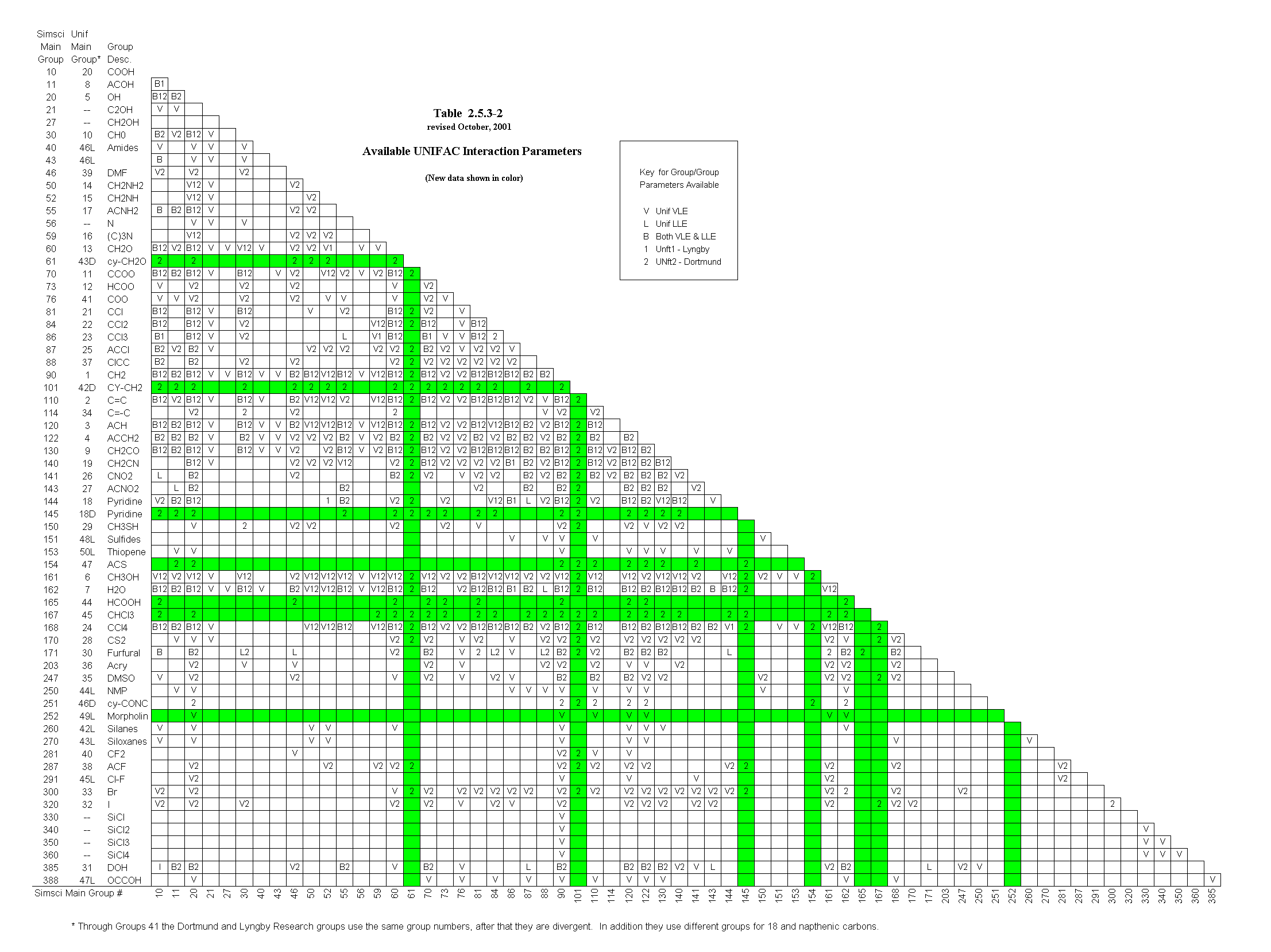
The UNIFAC (Universal Functional Activity Coefficient) method was developed by Fredenslund, Jones and Prausnitz. This method estimates activity coefficients with a group contribution concept. Interactions between two chemical compounds are assumed to be a function of group-group interactions where each compound is described in terms of its functional groups.
UNIFAC and its derivative methods like, UNIFAC TDEP-1, UNIFAC TDEP-2, UNIFAC TDEP-3 and UNIFAC Free Volume methods support CI and PUBLIC databanks also in addition to SIMSCI. PUBLIC databank is the new databank that is introduced in PRO/II 9.1 which contains the original UNIFAC structure IDs. To use the original UNIFAC structure IDs, the user can select PUBLIC databank from the databank search order in the available list of databanks for UNIFAC, DORTMUND (UNIFAC TDEP-2) models.
Note that PRO/II displays the SIMSCI Group IDs in the Component Properties- Define UNIFAC Structure window as shown in the figure below.

When the user selects two different databanks from the available databanks list for the current search order, PRO/II validates if these two databanks are of the same structure and same context. If they are of different structures then an error message appears and if the databanks are of different contexts,a warning pops up. SIMSCI and PUBLIC databanks cannot be selected simultaneously in the current search order as they use different structures. SIMSCI uses SIMSCI legacy group IDs where as PUBLIC databank uses original UNIFAC group IDs. Note that there is no one-to-one mapping for the structures available in SIMSCI with that of PUBLIC databank.
When PUBLIC is selected as the databank in current search order, the output report prints the original numbers as PUBLIC databank contains the original UNIFAC group IDs.
Different databanks available for different UNIFAC models are as shown in the table below.
Model |
Original UNIF |
Lyngby UTF1 |
Dortmund UTF2 |
Banks |
LEGACY SIMSCI CI PUBLIC |
LEGACY SIMSCI |
LEGACY SIMSCI PUBLIC |
Limited - Distribution Databanks is as shown in the table below :
Model |
Bank |
Original Dortmund |
CONSORTM CONSORTM |
From PRO/II 9.1 onwards, a separate system library that contains the UNIFAC Consortium data will be distributed to Consortium members. However, the distribution of this library is limited to Consortium members. Currently, this library supports the Original and Dortmund versions of the UNIFAC model.
For more information on this library, users can contact the UNIFAC Consortium.
The bank search order for UNIFAC databanks is handled in the same way as other databanks (SRK, NRTL, etc.).
The rules that apply during Bank Search Order are:
The first bank in the search order determines the structure mapping to be used for all components.
Databanks with a different structure mapping reference are flagged as errors because there is no way to reconcile different component structures.
The first bank in the search order also determines the preferred context to be used for all components.
Databanks with a different context produce warnings as they could lead to potential data inconsistencies.
The functional group concept is a convenient way to represent thousands of chemical compounds with a reasonable number of functional groups. Group-group interaction data are obtained from regression of experimental data for binary component pairs.
The UNIFAC method is based on the UNIQUAC model which represents the excess Gibbs energy as a combination of two effects; the combinatorial effect and the residual effect. The combinatorial effect is calculated directly from the UNIQUAC expression, using the area and volume parameters for the individual structural groups.
The residual effect is calculated with an expression that relates the residual activity coefficient to binary interaction parameters between the functional groups. The binary interaction parameters are assumed to be constant and not a function of temperature.
This method is very useful when no activity coefficient data are available for a component pair since it is predictive when the group interaction data are available for the groups comprising the component pair. An interaction grid identifying the available interactions for the UNIFAC method (and for the UNFT1 and UNFT2 modifications to it) is included below. The SIMSCI Main Group identifiers are given, as well as the main groups identified by the original research groups in Lyngby and Dortmund. New group data is indicated in color.

Refer "UNIFAC" in the PRO/II Reference Manual, Volume I, Chapter 2, for more information on this method.